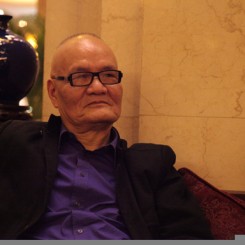By Jennifer Hall
Standing at a distance from the bubbling cauldron that is Chinese contemporary art, Vancouver-based Zheng Shengtian, Managing Editor of Yishu, remembers his work with Annie Wong and their early efforts to promote Chinese contemporary artists from abroad.
Vancouver is known widely as an Asian city in North America. A whopping 30 percent of its population is of Chinese descent due to its rich history of Chinese immigration, including a current wave of wealthy immigrants arriving from Mainland Chinese cities. So what about the city’s connections to Chinese contemporary art? All queries into the topic seemed to lead to Zheng Shengtian.
I met Zheng at a cafe near the Yishu office to discuss Vancouver’s links to Chinese contemporary art. Our conversation immediately turned to a discussion about Vancouver’s Jiangnan project. At a time when the elite international circles of the contemporary art world knew little of this upcoming phenomenon, Vancouver was a very important meeting place for Chinese contemporary artists, curators and scholars. Zheng describes Vancouver as “one of the pioneer cities of contemporary Chinese art. Back in the 1990s, Vancouver had more shows than any other city outside of Asia on contemporary Chinese art — and was the site of the Jiangnan project.”
Named after the lower reaches of the Yangtze River Delta, a region in China with a long history of artistic richness, Vancouver’s Jiangnan involved exhibitions at 12 Vancouver art galleries from March through May of 1998. It included a lecture series and an international symposium. “Xu Jiang, then the Vice-President of the China Academy of Art, came and he said that he had never seen any event like it in the whole world, so many shows about Chinese art together at a very high level. Xu Bing, Huang Yongping, Zhang Peili, all these important artists were in Vancouver. And that was at a time when other countries or cities did not have many chances to see one single Chinese art show.”
Before moving to Vancouver in 1990, Zheng had worked as a professor at the China Academy of Art in Hangzhou for 30 years. In the early 1990s, few people from Mainland China were immigrating to Vancouver. At first, he worked as a freelance artist and then as a curator and a writer. In 1995, he got involved with the Annie Wong Art Foundation. Zheng’s connections to the artistic communities of Hangzhou, Shanghai and Beijing were unique and complemented Wong’s network in Hong Kong and her financial resources. Together they set in motion many events that had a significant influence on the careers of Chinese artists such as Chen Zhen, Yang Fudong and Cai Guo-Qiang.
An artist herself, a generous philanthropist (daughter of late Hong Kong banker, merchant and philanthropist Dr. Leung Kau Kai), and a Vancouverite, Mrs Annie Wong Leung Kit Wah was intent on supporting and promoting Chinese contemporary art from outside of China. In 1995, she started a gallery, Art Beatus, in Vancouver to showcase Chinese art and also set up the Annie Wong Art Foundation, the first private Chinese foundation to support contemporary artists. Zheng became the director of the Gallery and the Foundation.
The venture took off and by 1998, they were spearheading the Jiangnan project and generally promoting the professional development of many Chinese contemporary artists. Zheng knew first-hand about the challenges faced by Mainland Chinese artists. At that time, contemporary art was criticized or ignored by the Chinese government and still viewed with suspicion by public audiences. “In the middle of the 1990s Chinese artists had very few resources: to find sponsors, to show their work — especially outside of China.”



